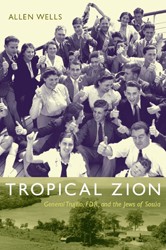Perhaps the most comprehensive discussion of the Jews of Latin America over the past forty years is Judith Laikin Elkin’s classic work: The Jews of Latin America. In this, the third edition of the book, Elkin discusses a number of the dynamic changes that have recently occurred in the communities of Latin America (for example, a changing response to Zionism) and considers the prospects for the future of those Jews who have managed to persist amidst the inhospitable conditions they encounter.
One of the most significant observations in this new edition is that the enthusiasm for Zionism that once inspired the Jews of the region is in dramatic decline. The concept of Zionism had long been a motivating force among Jews throughout the world. Prior to the twenty-first century, the Zionist ideal had roused Latin American Jews to allocate most of their charitable donations to Israel. Elkin reflects, “In a welter of Jewish ethnic and religious identities, Israel provided a unifying symbol.” But little by little, Jews were admitted into the surrounding culture until, as Elkin explains : “Jews are like other non-Latin, non-Catholic immigrants to Latin America, only more so.” As the external pressures and anti-Semitism decreased, the concentration on Israel diminished also. Attention in contemporary society appears to be redirected inward toward the local community.
Moreover, as interest in Zionism waned, interest in Judaism as a religion intensified. Nevertheless, Elkin argues that this growing interest in religion was inhibited in the face of seemingly inadequate outlets. The traditional Ashkenazi synagogues that had once been the focus for many Jews no longer held the same appeal for the third and fourth generations of Jews. With regard to the Sephardim,“Sephardic Orthodoxy retained tight control of its flock — until it could not.” The Jews of the present generation are nearly all native born. Dissatisfied with past approaches, they now confront an uncertain future.
Some have chosen the path of the baal teshuvah, moving more and more toward ultra-orthodoxy. Others strive for a renewal of Jewish life through a more progressive interpretation of the halakha (Jewish law). These alternative paths are certain to yield dissension within the Jewish community. Elkin also asserts that contemporary Latin American Jews are faced with another, even greater dilemma: whether to pursue a path to remain a part of the Jewish community, or elect to assimilate, becoming a part (though not an integral part) of the non-Jewish communities that surround them.
With excellent notes, an updated bibliography, and an index, this work is an invaluable source of information about the Jews of Latin America.
Related content:





